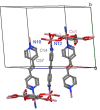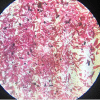Synthesis of UV-11 MOF and Its Characterization by Cyclic Voltammetry
- PMID: 32903784
- PMCID: PMC7438935
- DOI: 10.3389/fchem.2020.00617
Synthesis of UV-11 MOF and Its Characterization by Cyclic Voltammetry
Abstract
In this work a Metal-Organic Framework (MOF) was prepared using a solvothermal method, taking as precursors 1. 2-di-(4-pyridyl)-ethylene, 1.2.4.5-benzenetetracarboxylic acid and Co(No3)2-6H2O. This MOF was called UV-11 and was evaluated using microscopic, spectroscopic and electrochemical techniques. According to the obtained results, the melting point of the compound is located in a higher interval than its precursors. Stereoscopic microscopy analysis shows the presence of pink crystals in the form of needles. MEB technique displays a laminar morphology as well as crystals with approximate sizes (36 mm wide and 150 mm long). EDS analysis corroborated the presence of precursor elements such as cobalt, carbon and oxygen. Furthermore, the XRD technique shows the cobalt-related phases in the sample, which is cobalt bis (pyridine-6-carboxylic-2-carboxylate). A modified carbon paste electrode was prepared using MOF UV-11 and by cyclic voltammetry electrochemical technique, semi-reversible redox processes are identified, as well as thermodynamic and kinetic parameters were obtained with the Laviron equation, and electrochemical performance properties from the cyclic voltammetry experimental data.
Keywords: MOF (Metal–Organic Framework); characterization-analysis; electroanalysis; electrochemistry (cyclic voltametry); interface mechanical behavior; micro supercapacitor.
Copyright © 2020 Meza-Pardo, Morales-Tapia, Veloz Rodríguez, Reyes-Cruz, Perez-Labra, Urbano-Reyes, Rivera-Villanueva and Cobos-Murcia.
Figures









Similar articles
-
Chiral "doped" MOFs: an electrochemical and theoretical integrated study.Front Chem. 2023 Aug 8;11:1215619. doi: 10.3389/fchem.2023.1215619. eCollection 2023. Front Chem. 2023. PMID: 37614707 Free PMC article.
-
Enhanced glucose sensing based on a novel composite CoII-MOF/Acb modified electrode.Dalton Trans. 2018 Mar 12;47(11):3872-3879. doi: 10.1039/c8dt00296g. Dalton Trans. 2018. PMID: 29451291
-
Cerium-Based Metal-Organic Framework Nanocrystals Interconnected by Carbon Nanotubes for Boosting Electrochemical Capacitor Performance.ACS Appl Mater Interfaces. 2021 Apr 14;13(14):16418-16426. doi: 10.1021/acsami.1c02038. Epub 2021 Apr 5. ACS Appl Mater Interfaces. 2021. PMID: 33818075
-
Ascorbic Acid Determination Based on Electrocatalytic Behavior of Metal-Organic Framework MIL-101-(Cr) at Modified Carbon-Paste Electrode.J AOAC Int. 2019 Mar 1;102(2):625-632. doi: 10.5740/jaoacint.18-0135. Epub 2018 Aug 13. J AOAC Int. 2019. PMID: 30103843
-
Nickel and cobalt metal-organic-frameworks-derived hollow microspheres porous carbon assembled from nanorods and nanospheres for outstanding supercapacitors.J Colloid Interface Sci. 2020 Sep 1;575:96-107. doi: 10.1016/j.jcis.2020.04.083. Epub 2020 Apr 22. J Colloid Interface Sci. 2020. PMID: 32361050
Cited by
-
Free-Standing N-Doped Porous Carbon Fiber Membrane Derived From Zn-MOF-74: Synthesis and Application as Anode for Sodium-Ion Battery With an Excellent Performance.Front Chem. 2021 Apr 16;9:647545. doi: 10.3389/fchem.2021.647545. eCollection 2021. Front Chem. 2021. PMID: 33937196 Free PMC article.
References
-
- Alfonso-Herrera L. A., Huerta-Flores A. M., Torres-Martínez L. M., Rivera-Villanueva J. M., Ramírez-Herrera D. J. (2018). Hybrid SrZrO3-MOF heterostructure: surface assembly and photocatalytic performance for hydrogen evolution and degradation of indigo carmine dye. J. Mater. Sci. Mater. Electron. 29, 10395–10410. 10.1007/s10854-018-9096-y - DOI
-
- Betteridge W. (1980). The properties of metallic cobalt. Prog. Mater. Sci. 24, 51–142. 10.1016/0079-6425(79)90004-5 - DOI
LinkOut - more resources
Full Text Sources
Miscellaneous

